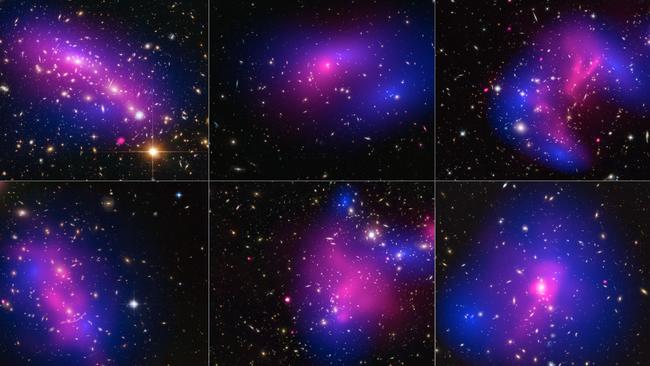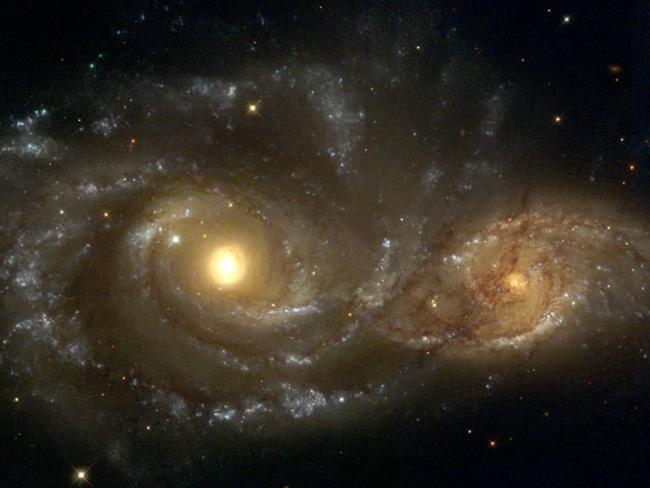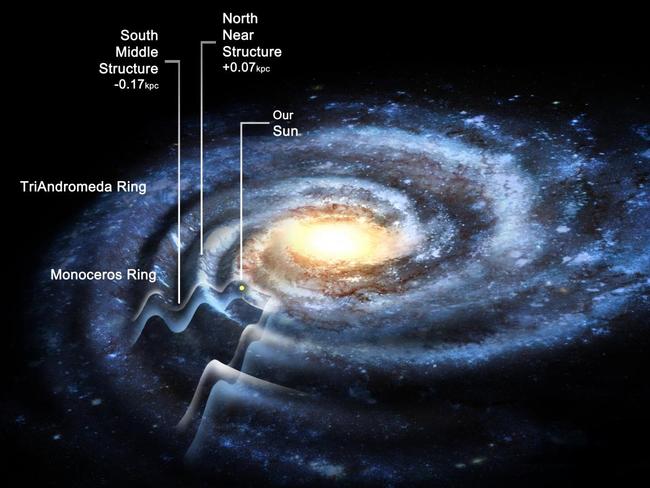Dark matter ‘insubstantial’, new study of galactic collision finds
THE UNIVERSE just got a whole lot spookier. The invisible structure holding everything together has been shown to be insubstantial — passing through itself as well as everything else.
THE universe just got a whole lot spookier. The invisible structure holding everything together has been shown to be insubstantial — passing through itself as well as everything else.
A study of data returned from NASA’s Hubble Space Telescope and the ESA’s Chandra X-ray Observatory has found dark matter does not slow down when it collides with itself.
This is significant as it shows the ghostly substance interacts with itself less than previously thought, narrowing down the options of what this invisible material might be.
Dark matter does not reflect or absorb light. But its presence can be seen through the gravitational influence it has on the space around it.
Without dark matter, galaxies such as our own Milky Way, would fly apart. There simply is not enough matter in a galaxy’s known stars and gas clouds to hold everything together.
It’s actually thought to make up about 90 per cent of the universe.
We just don’t know what it is.
“Dark matter is an enigma we have long sought to unravel,” NASA spokesman John Grunsfeld said. “With the combined capabilities of these great observatories, both in extended mission, we are ever closer to understanding this cosmic phenomenon.”

WHEN GALAXIES COLLIDE
To determine how substantial dark matter may be, astronomers have been analysing the collisions in large galaxy clusters.
Here we can see what happens to visible matter: The gas clouds surrounding each galaxy slam into each other and are thrown into swirls and eddies as they slow down or stop. The hopestars inside the galaxies, however, are not affected because of the huge distances between them.
Such physical effects of galaxy cluster collisions were measured by Chandra.
Astronomers Find Dark Matter Darker than Previously Thought. 3PM, TODAY #Hubblehangouts http://t.co/lwaPli2MkG pic.twitter.com/52EkM3Jsqs
— Hubble (@NASA_Hubble) March 26, 2015
“We know how gas and stars react to these cosmic crashes and where they emerge from the wreckage. Comparing how dark matter behaves can help us to narrow down what it actually is,” says the study’s lead author David Harvey.
The effects of such a collision on dark matter was tracked by Hubble. It did this through watching for the gravitational lensing effect dark matter has on light from galaxies behind it.
What astronomers found was the colliding dark matter clouds passed straight through the interstellar carnage without slowing each other down much.
“Atoms with their electrons are like you trying to run through a crowd with your arms outstretched - you’re going to collide with people,” Swinburne University astrophysicist Dr Alan Duffy explains. “Dark matter particles are like you with your arms pulled in, presenting a much smaller target and passing by each other and indeed through normal matter like a ghost.”

INSUBSTANTIAL SUBSTANCE
Astrophysicists have concluded in the study, published today in the journal Science, that dark matter is more insubstantial than expected: It does not interact with physical matter and has little frictional effect on itself.
“Had the dark matter dragged against other dark matter, the distribution of galaxies would have shifted,” a NASA statement reads.
The study has helped defined the properties of the mysterious substance behind dark matter, narrowing down the options of what it could be.
The team will now study if any portion of dark matter blobs have actually “bounced off” other dark matter particles by looking to see if the gravitational lensing effectchanges shape.
The results were combined from studies of 72 different collisions within large galaxy clusters.
“Each collision takes hundreds of millions of years, so in a human lifetime we only get to see one freeze-frame from a single camera angle,” team member Richard Massey says. “Now that we have studied so many more collisions, we can start to piece together the full movie and better understand what is going on.”
DWARFS HOLD THE CLUES
Dwarf galaxies appear to be a much more important player in our galactic neighbourhood than previously thought.
Another search for signs of ever elusive dark matter, this time by US Department of Energy’s Dark Energy Survey and Cambridge University, instead found nine new dwarf galaxies orbiting the Milky Way.
A dwarf galaxy is a cluster or 100 stars or so that is not part of the structure of Milky Way. They are bound by their own gravitational influence.
“The discovery of so many satellites in such a small area of the sky was completely unexpected,” says lead author Sergey Koposov. “I could not believe my eyes.”
Is dark matter behind mass extinction? The idea sounds good. But the facts don't add up. http://t.co/l5Abc7YCF5 pic.twitter.com/NuQEiZiREj
— Jamie Seidel (@JamieSeidel) February 25, 2015“Dwarf satellites are the final frontier for testing our theories of dark matter,” one of the study’s co-authors said. “We need to find them to determine whether our cosmological picture makes sense … we were not expecting to stumble on such treasure.”
Gravity is the only known telltale for ‘dark matter’ (so called as it does not absorb or emit light). Observing the influence of dark matter on the structure of dwarf galaxies is one of the most promising fields of study into the elusive substance.
“Dwarf satellites are the final frontier for testing our theories of dark matter,” said Dr Vasily Belokurov, one of the study’s co-authors. “We need to find them to determine whether our cosmological picture makes sense.”

OUR GROWING GALAXY
While dark matter has just become even more insubstantial, our neighbourhood just got bigger. A whole lot bigger.
A new analysis of the shape of the Milky Way galaxy has unravelled new ‘ripples’ of stars — making our intergalactic island 50 per cent larger than we thought.
The study, published in the latest edition of the Astrophysical Journal, explains the discovery of a previously unknown feature of our galaxy.
It is bent. Rippled. Layered.
“In essence, what we found is that the disk of the Milky Way isn’t just a disk of stars in a flat plane — it’s corrugated,” lead author of the paper Professor Heidi Jo Newberg says. “As it radiates outward from the sun, we see at least four ripples in the disk of the Milky Way. While we can only look at part of the galaxy with this data, we assume that this pattern is going to be found throughout the disk.”
Using data from the 2002 Sloan Digital Sky Survey, the “oscillations” in the Milky Way’s rings have been shown to extend the galaxy’s swirl further than previously expected.
Some clusters of stars previously thought to be on the edge of our galaxy have now been shown to be part of the disc structure. This means the known width of the Milky Way has just grown from 100,000 light years in diameter to 150,000 light-years.
Previous research had observed a rapid loss in the concentration of stars in the Milky Way beyond 50,000 light years from the galactic centre. Stars observed at about 60,000 years had appeared to form a “ring” around the galaxy’s edge.
“What we see now is that this apparent ring is actually a ripple in the disk,” Professor Yan Xu, one of the paper’s authors, said. “And it may well be that there are more ripples further out which we have not yet seen.”
“It’s very similar to what would happen if you throw a pebble into still water,” Professor Newberg says. “The waves will radiate out from the point of impact.
“If a dwarf galaxy goes through the disk, it would gravitationally pull the disk up as it comes in, and pull the disk down as it goes through, and this will set up a wave pattern that propagates outward.”
That means a lot of extra stars.
Boom. Bend. Repeat. The universe doesn’t only have a sense of humour. It’s also a tease. http://t.co/TtxcupQxbt pic.twitter.com/8XPUe4EaSB
— Jamie Seidel (@JamieSeidel) March 5, 2015



